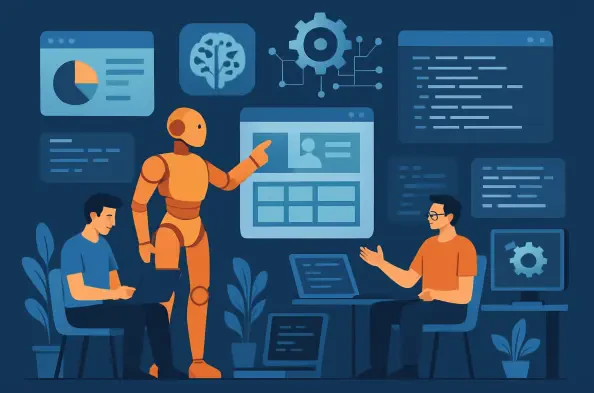In the fast-paced realm of software development, a revolutionary technology is emerging as a catalyst for change, fundamentally altering how software architects, project managers, and technical managers approach their work. Agentic AI, characterized by autonomous software agents driven by sophisticated artificial intelligence models, is no longer confined to assisting with coding tasks but is now making significant inroads into broader aspects of the software lifecycle. This cutting-edge technology offers a promise of heightened productivity, streamlined processes, and enhanced decision-making capabilities. Far from replacing human expertise, agentic AI positions itself as a collaborative partner, empowering professionals to tackle complex challenges with greater efficiency. As this innovation gains traction, it’s reshaping traditional workflows, allowing teams to focus on strategic and creative endeavors while delegating repetitive or data-intensive tasks to intelligent systems. This article delves into the profound impact of agentic AI across various roles, highlighting its potential to redefine the future of software development.
Redefining Design with Intelligent Systems
Agentic AI is proving to be an indispensable asset for software architects tasked with creating robust and scalable application frameworks. These intelligent agents excel at identifying critical design components, such as secure data pathways and encryption protocols, which might be missed during manual assessments. By rapidly producing initial architectural blueprints, AI enables architects to iterate designs with unprecedented speed, refining complex structures with a precision that saves significant time. This synergy between human insight and AI-driven efficiency, often termed seamless design collaboration, allows architects to focus on high-level innovation while the technology handles intricate details. The result is a more dynamic process that not only accelerates project timelines but also enhances the quality of the final output, ensuring systems are both resilient and aligned with modern standards.
Beyond the immediate benefits of speed and accuracy, agentic AI fosters a new way of approaching software architecture by integrating predictive insights into the design phase. These systems can analyze vast datasets to anticipate potential bottlenecks or vulnerabilities before they manifest, offering architects a proactive tool to address issues early. This forward-thinking capability means that designs are not just reactive to current needs but are built with future scalability and security in mind. While human oversight remains essential to validate AI suggestions against specific project goals or constraints, the technology significantly reduces the manual workload. Architects can dedicate more energy to strategic planning and creative problem-solving, confident that foundational elements are already mapped out with a high degree of reliability. This partnership is setting a new benchmark for how architectural design can evolve in an increasingly digital landscape.
Streamlining Project Coordination with Automation
For project managers grappling with the intricacies of timelines, resources, and team dynamics, agentic AI emerges as a powerful ally in simplifying these challenges. This technology automates the creation of detailed project plans, mapping out dependencies and scheduling tasks with a level of detail that often surpasses human capacity under tight deadlines. By processing numerous variables—ranging from team availability to budget limits—AI agents deliver actionable roadmaps that keep projects on course. This automated approach allows managers to shift their focus toward fostering team collaboration and addressing high-priority issues, rather than getting bogged down in logistical minutiae. The concept of intuitive project orchestration through AI highlights how technology can enhance efficiency without diminishing the critical human element of leadership and adaptability.
Moreover, agentic AI brings a layer of consistency and foresight to project management that manual methods struggle to match. These systems can simulate various project scenarios, identifying risks and suggesting mitigation strategies before problems arise. For instance, an AI might flag potential resource shortages well in advance, enabling managers to reallocate assets proactively. While the technology cannot fully account for every human or organizational variable, its outputs serve as a solid foundation that can be fine-tuned with expert judgment. This balance ensures that project plans are both data-driven and contextually relevant, reducing the likelihood of costly delays or missteps. As a result, project managers equipped with AI tools are better positioned to deliver results on time and within budget, maintaining stakeholder confidence in an era where agility is paramount.
Aligning Technology with Strategic Objectives
Technical managers, who often serve as the bridge between technical teams and business leadership, find immense value in the capabilities of agentic AI to harmonize these dual responsibilities. By automating the analysis of project scope, budget forecasts, and risk assessments, AI provides a clear picture of how technical initiatives align with overarching business goals. This rapid generation of insights facilitates smoother communication between departments, ensuring that technical plans are not only feasible but also contribute to strategic priorities. The ability to present data-backed projections helps technical managers advocate for necessary resources or adjustments, fostering a collaborative environment where decisions are informed and purposeful. This integration of AI underscores its role as a facilitator of cross-functional alignment.
Additionally, the use of agentic AI in this context allows technical managers to anticipate challenges that might disrupt the balance between technical execution and business expectations. These tools can highlight discrepancies in project timelines or budget allocations early on, offering actionable recommendations to address them. While human expertise is still required to interpret these insights within the unique context of an organization, the technology significantly lightens the analytical load. This enables managers to dedicate more time to strategic oversight and relationship-building with stakeholders, ensuring that projects deliver tangible value. As AI continues to refine its predictive and analytical capabilities, its role in supporting technical managers will likely expand, further solidifying its importance in achieving cohesive and successful outcomes across diverse teams and objectives.
Navigating Obstacles in AI Integration
Despite the transformative potential of agentic AI, integrating this technology into software development workflows comes with notable challenges that must be addressed for optimal results. A primary concern is the risk of inaccurate outputs when the instructions provided to AI agents lack specificity or depth. Vague inputs can lead to results that miss the mark, necessitating multiple iterations to achieve the desired accuracy. This iterative process, while sometimes time-intensive, underscores the importance of clear communication with AI systems. Professionals must refine their approach to prompting, ensuring that the technology receives the context it needs to produce relevant and reliable outputs. Human review remains a critical step to catch and correct any misalignments, highlighting that AI is a tool to augment, not fully automate, complex decision-making.
Another significant hurdle is the inability of agentic AI to fully comprehend organizational or bureaucratic constraints unique to specific environments. For example, an AI might suggest a technical solution that overlooks internal policies requiring manual approvals for certain actions, leading to impractical recommendations. This limitation emphasizes the indispensable role of human judgment in tailoring AI-generated plans to fit real-world conditions. While these challenges may seem daunting, they are manageable through a combination of iterative refinement and strategic oversight. By viewing AI as a starting point rather than a final solution, teams can leverage its strengths while compensating for its gaps. Addressing these obstacles head-on ensures that the adoption of agentic AI remains a net positive, enhancing workflows without compromising on precision or relevance.
Exploring Practical Outcomes and Future Horizons
The real-world impact of agentic AI is already evident in diverse software development projects, showcasing its ability to drive efficiency and clarity. Take, for instance, the implementation of security log management systems on cloud platforms, where AI agents have scoped out project requirements, identified necessary roles, and estimated budgets with remarkable speed. Similarly, in the creation of technical specifications for software tools, AI has enabled teams to draft comprehensive plans in hours rather than days. These cases illustrate how the technology can condense timelines and improve coordination among stakeholders, even as human input refines the final deliverables. Such practical applications serve as compelling evidence of AI’s capacity to transform traditional processes into more agile and effective endeavors.
Looking toward the future, the trajectory of agentic AI suggests even greater possibilities for innovation within software development. Current implementations are often seen as early proofs of concept, hinting at a broader scope of integration yet to be fully explored. As the technology matures, it could unlock novel approaches to collaboration, problem-solving, and system design, benefiting not just individual roles but entire technical ecosystems. The ongoing evolution of AI tools will likely address existing limitations, such as better contextual understanding, further enhancing their utility. For teams willing to adapt and experiment, the coming years promise a landscape where agentic AI plays a central role in driving efficiency and innovation, setting the stage for a more interconnected and responsive approach to building software solutions.






